acetic acid. A pungent, colorless liquid acid that is the primary acid in vinegar (vinegar is 5% acetic acid). Acetic acid is what makes vinegar sour.
acid. Any substance in a class of sour compounds.
antioxidant. A substance, such as citric acid (lemon or lime juice), ascorbic acid (vitamin C) or a blend of citric and ascorbic acids, that inhibits oxidation and controls browning of light-colored fruits and vegetables. Antioxidants are believed to neutralize free radicals, harmful particles in your body that can cause long-term damage to cells and lead to disease.
artificial sweetener. Any one of many synthetically produced non-nutritive sweet substances. Artificial sweeteners vary in sweetness but are usually many times sweeter than granulated sugar.
ascorbic acid. The chemical name for vitamin C, a natural, water-soluble vitamin that is commercially available in a concentrated form as white, odorless crystals or powder. It is used as an antioxidant to inhibit oxidation and control browning of light-colored fruits and vegetables.
bacteria. Microorganisms, some of which are harmful, found in the soil, water and air around us. Some bacteria thrive in conditions common in low-acid preserved food and produce toxins that must be destroyed by heating to 240°F (116°C) for a specified length of time. For this reason, low-acid foods must be processed in a pressure canner.
blanch. To submerge a food in boiling water or steam for a short period of time, done to loosen the skin or peel or to inactivate enzymes. Blanching is immediately followed by rapidly cooling the food in ice water.
boil. To heat a liquid until bubbles break the surface. At sea level, this happens at 212°F (100°C). At elevations above 1,000 feet (305 m), the boiling point is reached at a lower temperature. A boil is achieved only when the liquid is continuously rolling or actively bubbling. See also boil gently or simmer or boil, full rolling.
boil gently or simmer. To cook food gently just below the boiling point (180°F to 200°F/82°C to 93°C). Bubbles rise from the pot bottom, only slightly disturbing the surface of the food.
boil, full rolling. A rapid boil, usually foaming or spurting, that cannot be stirred down, achieved at a temperature of 220°F (104°C). This stage is essential for attaining a gel when making cooked jams or jellies.
boiling point. The temperature at which liquid reaches a boil (212°F/100°C at sea level).
boiling water canner. A large, deep saucepan equipped with a lid and a rack to lift jars off direct heat. The pot must be deep enough to fully surround and immerse jars in water by 1 to 2 inches and allow for the water to boil rapidly with the lid on. If you don’t have a rack designed for preserving, use a cake cooling rack or extra bands tied together to cover the bottom of the pot.
boiling water method. The fresh preserving method used to process high-acid foods. Heat is transferred to the food product by the boiling water, which completely surrounds the jar and two-piece closure. A temperature of 212°F (100°C) is reached and must be maintained for the time specified by the recipe. This method is adequate to destroy molds, yeasts and some bacteria, as well as to inactivate enzymes. The boiling water method must not be used to process low-acid foods.
botulism. Food poisoning caused by the ingestion of the toxin produced by spores of the bacterium Clostridium botulinum. Botulism can be fatal. The spores are usually present in the dust, wind and soil clinging to raw food. They belong to a species of bacteria that cannot grow in the presence of air, and they do not normally thrive in high-acid foods. The spores can survive and grow in any tightly sealed jar of low-acid food that has not been processed correctly. Using the correct processing temperature and time to preserve low-acid foods will destroy toxin-producing spores.
bouquet garni. A spice bag, or a square of cheesecloth tied into a bag, that is filled with whole herbs and spices and is used to flavor broth, soup, pickling liquid and other foods. This method allows for easy removal of the herbs and spices after cooking.
brine. A salt-water solution used in pickling or when preserving foods. Although salt and water are the main ingredients, sugar and spices are sometimes added.
brined pickles. See fermented pickles.
bubble remover. A non-metallic utensil used in fresh preserving to remove or free air bubbles trapped inside the jar. To ensure appropriate headspace, air bubbles should be removed before the two-piece closure is applied.
candy or jelly thermometer. A kitchen thermometer that usually comes with adjustable hooks or clips to allow it to be attached to the pan. During the preparation of soft spreads without added pectin, it is used to determine when the gel stage is reached (this occurs at 220°F/104°C, or 8°F/4°C) above the boiling point of water). Always insert the thermometer vertically into the jelly and ensure that it does not contact the pot surface.
canner. Either one of two pieces of equipment used in fresh preserving to process jars filled with a food product and covered with a two-piece closure. The two types of canners recommended for use in fresh preserving are a boiling water canner for high-acid foods and a pressure canner for low-acid foods.
canning/preserving liquid. Any one of many types of liquids, such as water, cooking liquid, pickling liquid, broth, juice or syrup, used to cover solid food products. Adding liquid prevents darkening of food exposed to the surface and allows for heat penetration.
cheesecloth. A lightweight, woven cloth that has many uses in the kitchen. For fresh preserving, it can be used in place of a jelly bag to strain juice from fruit pulp when making jelly or homemade juice, or it can be formed into a bag to hold whole herbs and spices during the cooking process, aiding in easy removal.
chutney. A combination of vegetables and/or fruits, spices and vinegar cooked for a long period of time to develop favorable flavor and texture. Chutneys are highly spiced and have a sweet-sour blending of flavors.
citric acid. A natural acid derived from citrus fruits, such as lemons and limes. It is available as white crystals or granules and is used as an ingredient in commercial produce protectors to prevent oxidation and in pectin products to aid in gel formation by increasing the acidity of the jam or jelly.
ClearJel®. A commercially available modified food starch that is approved for use in fresh preserving. Unlike regular cornstarch, products thickened with ClearJel® do not break down when heated to high temperatures and/or cooled and reheated. ClearJel® can be ordered from online sources or by mail order.
conserve. A soft spread similar to jam, made with a combination of two or more fruits, along with nuts and/or raisins. If nuts are used, they are added during the last five minutes of cooking.
cool place. A term used to describe the best storage temperature for fresh preserved products. The ideal temperature is 50°F to 70°F (10°C to 21°C).
crisping agent. Any one of many substances that make pickles crisp and firm. Some older pickling recipes call for pickling lime, alum or grape leaves to crisp pickles, but these are no longer recommended. Using fresh, high-quality produce, the correct ingredient quantities and a current, tested fresh preserving recipe will produce firm pickles without the addition of crisping agents. The texture of some quick-process or fresh-pack pickles, however, can be enhanced with the use of a product called Pickle Crisp® powder.
cucumber, pickling. A small variety of cucumber used to make pickles. Pickling cucumbers are usually no more than 6 inches (15 cm) in length. Cucumbers deteriorate rapidly at room temperature and should be stored in the refrigerator and used within 24 hours of harvest.
dial-gauge pressure canner. A pressure canner fitted with a one-piece pressure regulator and a gauge to visually indicate the correct pressure level.
E. coli. A species of bacteria that is normally present in the human intestines. A common strain, Escherichia coli 0157:H7, produces high levels of toxins and, when consumed, can cause symptoms such as diarrhea, chills, headaches and high fever. In some cases, it can be deadly.
fermentation. A reaction caused by yeasts that have not been destroyed during the processing of preserved food. Bubble formation and scum are signs that fermentation is taking place. With the exception of some pickles that use intentional fermentation in preparation, do not consume fermented fresh preserved foods.
fingertip-tight. The degree to which screw bands are properly applied to fresh preserving jars. Use your fingers to screw band down until resistance is met, then increase to fingertip-tight. Do not use a utensil or the full force of your hand to over-tighten bands.
fresh-pack pickles. Cucumbers that are preserved in a spicy vinegar solution without fermenting, although they are frequently brined for several hours or overnight. All fresh-pack pickles should stand for 4 to 6 weeks after processing to cure and develop optimal flavor.
fruit butter. A soft spread made by slowly cooking fruit pulp and sugar to a consistency thick enough to mound on a spoon and spread easily. Spices may be added.
fruit pickle. Fruit, usually whole, that is simmered in a spicy, sweet-sour syrup until it becomes tender or transparent.
funnel. A plastic utensil that is placed in the mouth of a fresh preserving jar to allow for easy pouring of a food product into the jar. Funnels help prevent spillage and waste.
gasket. A rubber ring that sits along the inside circumference of a pressure canner lid and comes in contact with the base when locked into place. The gasket provides a seal between the lid and the base so steam cannot escape.
gelling agent.Any substance that acts to form a gel-like structure by binding liquid.
gel stage. The point at which a soft spread becomes a full gel. The gelling point is 220°F (104°C), or 8°F (4°C) above the boiling point of water.
headspace. The unfilled space in a fresh preserving jar between the top of the food or liquid and the underside of the lid. The correct amount of headspace is essential to allow for food expansion as the jars are heated and for the formation of a strong vacuum seal as jars cool.
high-acid food. A food or food mixture that contains sufficient acid — naturally or added as an ingredient — to provide a pH value of 4.6 or lower. Fruits, fruit juices, tomatoes, jams, jellies and most soft spreads are naturally high-acid foods. Food mixtures such as pickles, relishes, salsas and chutneys contain added vinegar or citric acid, which lowers their pH, making them high-acid foods. High-acid foods can be safely processed in a boiling water canner.
hot-pack method. Filling jars with preheated, hot food prior to heat processing. Preheating food expels excess air, permits a tighter pack in the jar and reduces floating. This method is preferred over the raw-pack method, especially for firm foods.
jam. A soft spread made by combining crushed or chopped fruits with sugar and cooking to form a gel. Commercial pectin may or may not be added. Jams can be made with a single fruit or with a combination of fruits. They should be firm but spreadable. Jams do not hold the shape of the jar.
jelly. A soft spread made by combining fruit juice or acidified vegetable juice with sugar and cooking to form a gel. Commercial pectin may or may not be added.
jelly bag. A mesh cloth bag used to strain juice from fruit pulp when making jellies. A strainer lined with many layers of cheesecloth may be substituted. Both the jelly bag and cheesecloth need to be dampened before use.
jelly strainer. A stainless steel tripod stand fitted with a large ring. A jelly bag is placed over the ring. The stand has feet that hold it onto a bowl to allow juice to strain from the bag into the bowl.
lemon juice. Juice extracted from lemons that is added to food products to increase the acidity. Lemon juice can also be purchased commercially. In fresh preserving, lemon juice is added to certain foods to increase acidity and ensure proper processing. In some soft spread recipes, especially those prepared with added pectin, the acid in the lemon juice also aids with gelling. The acidity of freshly squeezed lemon juice is variable, depending on the lemon variety and harvest conditions, whereas bottled lemon juice is produced to consistent acidity standards. In recipes that specify bottled lemon juice, it is crucial for the success of the final product not to use freshly squeezed lemon juice. Where bottled is not specified, either freshly squeezed or bottled lemon juice may be used.
lid. A flat metal disc with a flanged edge lined with sealing compound used in combination with a metal screw band for vacuum-sealing fresh preserving jars.
low-acid food. A food that contains little natural acid and has a pH higher than 4.6. Vegetables, meat, poultry and seafood are all low-acid foods. Bacteria thrive in low-acid foods. The only recommended and practical means of destroying bacteria naturally found in low-acid foods is to heat the food to 240ºF (116ºC) (at sea level) for a specified time in a pressure canner.
marmalade. A soft spread that contains pieces of citrus fruit and peel evenly suspended in transparent jelly. Marmalade is cooked in small batches and brought rapidly to, or almost to, the gelling point. Marmalades are similar in structure to jam.
mold. Microscopic fungi that grow as silken threads and appear as fuzz on food. Molds thrive on acids and can produce mycotoxins. Mold is easily destroyed at processing temperatures between 140ºF and 190ºF (60ºC and 88ºC).
pectin. A naturally occurring carbohydrate found in fruits and vegetables that is responsible for cell structure. The natural pectin content decreases as fruits and vegetables ripen. Thus, they become soft and lose their structure. Pectin is available commercially in powdered and liquid forms. Commercial pectin is used to make jams, jellies and other soft spreads.
pickling. Preserving food, especially cucumbers and vegetables, in a high-acid (vinegar) solution, often with spices added for flavor. Pickled foods must be processed in a boiling water canner.
preserves. A soft spread in which the fruit is preserved with sugar so it retains its shape and is transparent, shiny, tender and plump. The syrup varies from the thickness of honey to that of soft jelly. A true preserve does not hold its shape when spooned from the jar.
preserve. To prepare foods to prevent spoilage or deterioration for long periods of time. Some methods of preservation are fresh preserving (home canning), freezing, dehydration, pickling, salting, smoking and refrigeration. The method used determines the length of time the food will be preserved.
pressure canner. A tall, usually heavy pot with a lid that is locked in place and a pressure-regulating device. The lid is fitted with a safety valve, a vent and a pressure gauge. Pressure canners are used to process low-acid foods, because steam at 10 lbs (68 kPa) of pressure (at sea level) will reach 240°F (116°C), the temperature needed to destroy harmful bacteria that thrive in low-acid foods.
pressure canning/preserving method. The fresh preserving method used to heat-processs low-acid foods. Low-acid foods must be processed in a pressure canner in order to destroy potentially harmful bacteria, their spores and the toxins they produce. In practical terms, this can be done at 240°F (116ºC). Because the steam inside the canner is pressurized, its temperature can exceed the boiling point of water (212°F/100°C). In a weighted-gauge canner at sea level, the temperature will reach 240°F (116ºC) at 10 lbs (68 kPa) of pressure.
processing time. The time in which filled jars are heated in a boiling water canner or a pressure canner. The processing time must be sufficient to heat the coldest spot in the jar. The processing time is specified for every current, tested fresh preserving recipe and depends on several factors, such as acidity, type of food product and size of jar.
raw-pack method.Filling jars with raw, unheated food prior to heat processing.
relish. A pickled product prepared using chopped fruits and/or vegetables cooked in a seasoned vinegar solution. If a sweet relish is desired, sugar is added. Hot peppers or other spices may also be added for flavor.
reprocessing. Repeating the heat processing of filled, capped jars when a lid does not seal within 24 hours. The original lid must be removed and the food and/or liquid reheated as recommended by the recipe. The food and/or liquid must be packed into clean, hot jars and covered with a new, clean lid with the screw band adjusted. The filled jars must then be reprocessed using the preserving method and full length of processing time recommended by the recipe.
salt, kosher. A coarse-grained, textured salt that is free of additives. Kosher salt may be used when making pickles. Because of the variance in density and form, contact kosher salt packers for information regarding equivalencies.
salt, pickling or preserving. A fine-grained salt used in pickling and fresh preserving. It is free of anti-caking agents, which can cause the pickling liquid to turn cloudy, and iodine, which can darken the pickles.
screw band. A threaded metal band used in combination with a flat metal lid to create vacuum seals for fresh preserved food. The band holds the lid in place during processing.
sealing compound. The red, shiny material, also called plastisol, found in the exterior channel on the underside of the flat metal lid. The sealing compound comes in contact with the lip of the jar and forms a seal when the jar cools after processing.
spice bag. A small muslin bag used to hold whole herbs and spices during cooking. The bag allows the flavor of the herbs and spices to seep into the food or liquid, and makes removing the spices easy when cooking is complete. Spice bags come in various sizes. If a spice bag is not available, tie herbs and spices in a square of cheesecloth.
syneresis. The separation of liquid from a gel. In fresh preserving, this can happen to soft spreads, usually during storage. It is not a safety concern.
syrup or canning/preserving syrup. A mixture of water (or juice) and sugar used to add liquid to canned food, usually fruit.
two-piece closure. A two-piece metal closure for vacuum-sealing fresh preserving jars. The set consists of a metal screw band and a flat metal lid with a flanged edge lined with sealing compound.
vacuum seal. The state of negative pressure in properly heat-processed jars of home-canned foods. When a jar is closed at room temperature, the atmospheric pressure is the same inside and outside the jar. When the jar is heated, the air and food inside expand, forcing air out and decreasing the internal pressure. As the jar cools and the contents shrink, a partial vacuum forms. The sealing compound found on the underside of fresh preserving lids prevents air from re-entering.
venting. 1.) Forcing air to escape from a closed jar by applying heat. As a food or liquid is heated, it expands upward and forces air from the jar through pressure buildup in the headspace. 2.) Permitting air to escape from a pressure canner, also called exhausting.
vinegar, distilled white. The standard form of vinegar. It is a clear, colorless acidic liquid derived from grain alcohol that possesses a sharp, pungent flavor. Unlike apple cider vinegar or malt vinegar, distilled white vinegar does not compete with the distinctive flavors of herbs and spices in brine. Because it is clear, it does not change the color of white or light-colored fruits and vegetables. In fresh preserving, use 5% acidity (50 grain).
vinegar, cider. A type of vinegar derived from apples that is light golden in color and has a tart fruit flavor. Cider vinegar has a milder flavor than distilled white vinegar. Because it has color, it may darken white or light-colored fruits and vegetables. In fresh preserving, use 5% acidity (50 grain).
vinegar, red or white wine. A type of vinegar derived from wine. The flavor reflects the source of the wine.
weighted-gauge pressure canner. A type of pressure canner that is fitted with either a three- or a one-piece weight unit, both with 5-, 10- and 15-lb (35, 69 and 103 kPa) pressure adjustments. (Only 10- and 15-lb/69 and 103 kPa pressure weights are used in fresh preserving. The 5-lb/35 kPa weight is used for cooking, but not preserving.) Steam, exhausted throughout the processing period, causes the weight(s) to rock, indicating that the pressure level has been achieved or is being maintained.
yeast. Microscopic fungi grown from spores that cause fermentation in foods. Yeasts are inactive in foods that are frozen and are easily destroyed by heat processing at a temperature of 212°F (100°C).

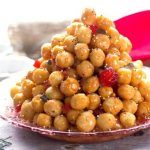
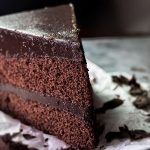
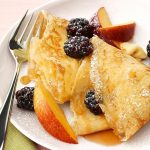
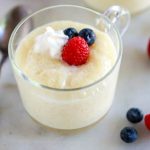
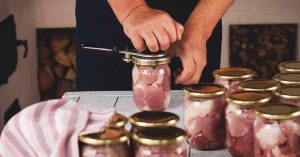
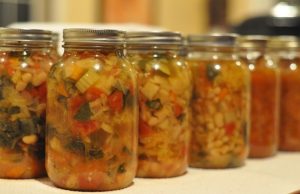
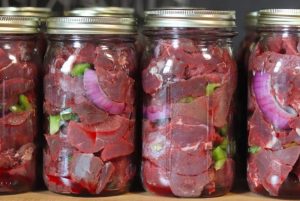
Leave a Reply